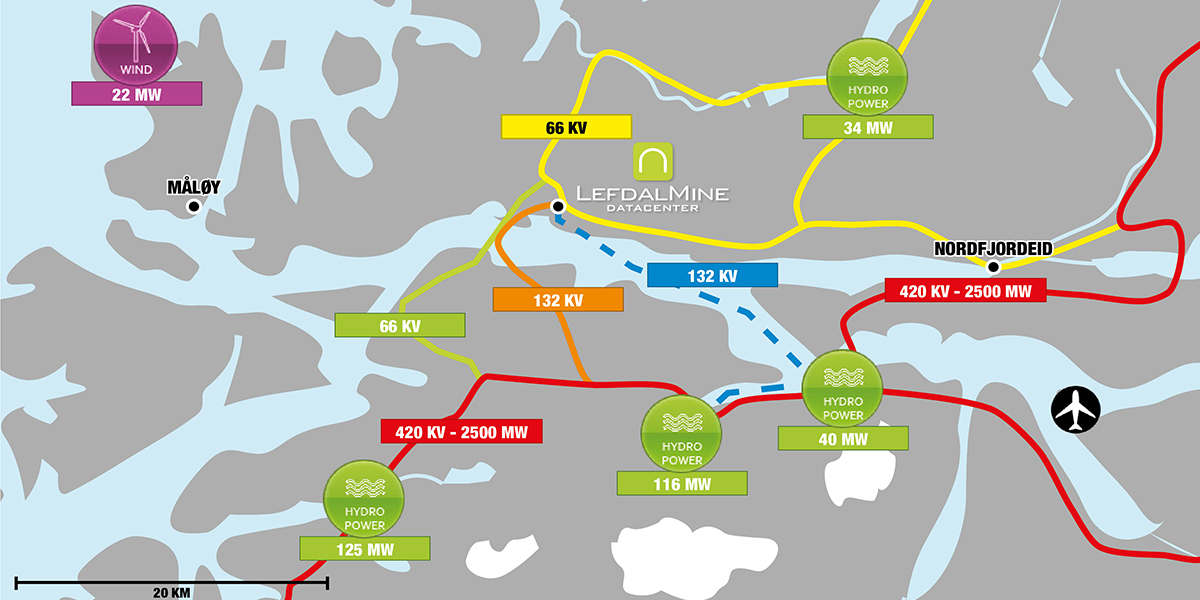Two months ago, we posted about Denmark as the new place to be for data centers following recent announcements/updates from Apple and Facebook to build huge data centers, exceeding each 150,000 m2 size. In the same post we discussed Norway as the likely next new place to be due to its cold air for cooling data centers, low price for green, renewable, carbon-neutral power, developable land, educated workforce, proximity to transmission infrastructure with multiple dark fiber options for physically-diverse connectivity, strong local support for high tech jobs, and positive business climate. All these arguments are combined in the recent news from Lefdal Mine Datacenter announcing the official opening on 10 May 2017 of a new data center in Norway, with the completion of the build out of Phase 1 offering a cooling capacity of 45 MW ready for use.

Lefdal Mine Datacenter is exploiting the Norwegian benefits listed above together with the re-use of an old mine to create a unique and ambitious data center facility in Europe.


The mine today is made of 28 km of tunnels over six levels (with the potential to expand to 14 according to Mats Andersson, CEO for the project), which are divided into 75 chambers with a potential white space area of 120,000 m2 and 200+ MW IT capacity. The levels are connected by a paved road that descends in a spiral through tunnels that are 45 feet wide and almost 30 feet high. Just one of those levels could host all the current servers in Norway. The chamber height ranges from 11 to 18 m, while temperature is 8°C. By essence, this underground location offers a high level of natural protection against Electro Magnetic Pulse (EMP). The IT capacity can be delivered in traditional white space or container solutions.



Renewable Power
Norway has a unique power proposition, with large surplus production of green, low-cost power. Norway is ranked number 1 in the world on secure, accessible and diversified energy supply. Lefdal Mine Datacenter is located near 350 MW renewable power production. Furthermore, the national grid is next to the facility with a capacity of 2 500 MW. The total power production in the area is presently 12.7 TWh (100 % renewable), with a surplus power of 6.7 TWh!

Efficient Cooling
Cold seawater is used as cooling source through a heat exchanger for a closed fresh water circuit. The proximity to the 110-km long, 565-m deep Nordfjord ensures access to unlimited 8 C seawater at the temperature of 8°C all year around. The mine is situated just below sea level so there is no need to use energy lifting the sea water that cools down the fresh water circuit from 30°C to 18°C.
Power Usage Effectiveness (PUE) is the total energy used by a data center divided by the energy used by ICT equipment in that data center. Lefdal Mine Datacenter’s cooling solution leads to a PUE ranging from 1.08 to 1.15 – depending on power supply configuration and scale of capacity (PUE lower than 1.15 is guaranteed 24/7/365). Less than 3% of the power spent on IT is used for cooling with a 5 KW/rack configuration.


Extremely Green
Lefdal Mine Datacenter positions itself as Europe’s greenest data center with low PUE operation on renewable power, zero-CO2 emission, limited footprint and no need for evaporative systems for cooling. The mine was already there and the amount of material required to build out capacity was low. The main part of the facility is not visible to the surroundings. There is no need for evaporative systems for cooling and the Water Usage Effectiveness (WUE) is zero.
Note: WUE, or Water Usage Effectiveness, is a sustainability metric created by The Green Grid in 2011 to attempt to measure the amount of water used by datacenters to cool their IT assets. WUE is the ratio between the annual site water usage in liters and the IT equipment energy usage in kilowatt hours (Kwh). Water usage includes water used for cooling, regulating humidity and producing electricity on-site.



This abandoned mine-turned data center is very likely to be the largest green data center in Europe, where the two common factors usually limiting data center build out and expansion, namely physical real estate and power capacity, disappear.
For comments or questions, please contact us.
Note: The illustrations for this post comes from Lefdal Mine Datacenter website.

